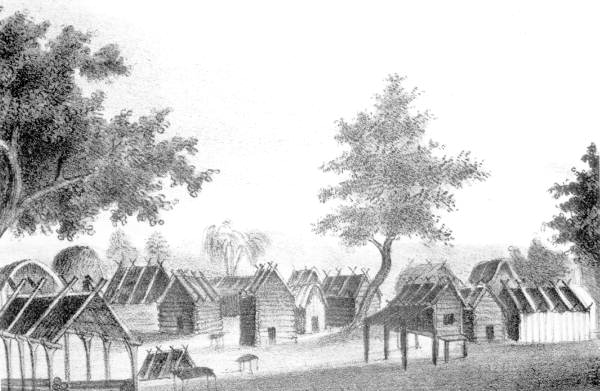
Seminole Village, 1835
Event Summary
In 1821, Spain gave control of Florida over to the U.S. government.
General Andrew Jackson provoked the first Seminole war by venturing into sovereign Seminole country.
The conflicts lasted for years, with most Seminoles either killed or forced to move off their lands to make way for White settlers.
Today, only a few Seminoles still remain on reservation lands in Florida.
- First Seminole War: 1817-1818
- Second Seminole War: 1835-1842
- Third Seminole War: 1855-1858
 |
| Andrew Jackson |
.png) Adams-Onis Treaty (1819)
Adams-Onis Treaty (1819)
Portraits of Seminole Leaders of the Second Seminole War
Histories and Source Documents
 |
| Florida Indian leader Osceola |
Osceola: Chief of the Seminoles from National Park Service
A Seminole Warrior Cloaked in Defiance, Smithsonian Magazine (October 2010)
Osceola's Last Words, a song by Will McClean, sung by David Summerford
December 25, 1837: Christmas Day Freedom Fighters: Hidden History of the Seminole Anticolonial Struggle, Zinn Education Project
The true histories and nuances of the Seminole Nation's resistance to US expansionist violence is often quickly pass over in traditional curriculums.
The Seminoles had established southern Florida as their sovereign homeland after fleeing from ethnic cleansing taking place under the Creek nation which lived in Alabama and Georgia. The Seminole Nation was (before the start of the Seminole wars) not part of the territorial US and escaped slaves would flee to Seminole territory where they were welcomed and given total freedom to live amongst the Seminole peoples. As a result, the Seminoles were a multicultural and multiracial community of both free blacks and native peoples. Southern plantation owners hated the fact that the Seminole Nation was an outpost of freedom and saw it as a threat to their economic system. The motivation for invading the Seminole Nation was thus one of racist economic motives - to stamp out what was seen as a threat to US colonial slavery and political power.
Throughout the Seminole Wars, the African and Native fighters of the Seminole nation put up a serious fight. The Florida terrain was treacherous to the US army and the Seminole fighters often engaged in guerilla-style attacks that decimated US army troops. The US army engaged in "scorched Earth" ethnic cleansing of Seminole villages and farms, which eventually wore down the Seminoles ability to fight back. The eventual result was that Seminole leaders, like Chief Osceola, were captured and killed and the Nation had to forcibly agree to relocation along the Trail of Tears to modern day Oklahoma. The few remaining Seminole were forced onto reservations in Southwest Florida.
The Seminole Wars, though often not seen as such, are an important event in understanding the shared history between Natives and freed black slaves in the US.
Comments (0)
You don't have permission to comment on this page.